City Farmer's Waterwise Demonstration Garden
Six Steps to a Waterwise Garden
Get a rain barrel.
Mulch your flower and vegetable beds (with compost, leaves or straw).
Let your lawn go brown in the summer.
- Install soaker hoses.
Leave your clippings on the lawn.
Consider drought tolerant plants.
Judith Cowan is currently re-developing the Waterwise Demonstration Garden at the City of Vancouver's Compost Demonstration Garden at 2150 Maple Street. (The garden was created by Ross Waddell in 1995.) Contact: composthotline@telus.net
Our Coastal Temperate Rainforest
We dwell in the midst of a coastal temperate rainforest. As a result, our landscape expresses the abundance of water in the types of plants that grow here (a proliferation of mosses, ferns and herbaceous perennials), lush growth and a long growing season. Vancouver has cool, wet winters and warm, dry summers. The majority of the rain falls during winter and spring leaving the summer months in a state of drought like conditions.
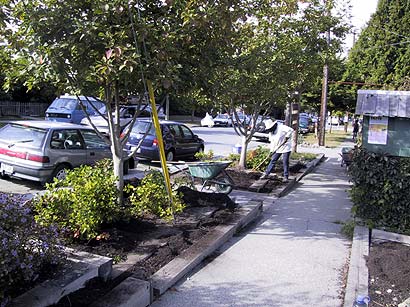
The Lower Mainland places the greatest demand on its water supply when the storage of the reservoirs are at their lowest. During the summer the GVRD implements sprinkling regulations in order to conserve water by limiting the watering of lawns. These restrictions are necessary as they control the demand placed on our water supply during the summer and heighten public awareness on the preciousness of this essential element. Using the principles of waterwise gardening will help to prevent unnecessary wastage, ensuring clean water for all and future generations.
What is waterwise gardening?
Waterwise gardening is not synonymous with xeriscaping. Xeriscaping is the term used for landscaping in areas that have extended periods of drought and dry weather (or xeric climates) such as the southern United States. Waterwise gardening is a more appropriate explanation for gardening in mesic climates like Vancouver and incorporates the collection and storage of rainwater, soil health, maintenance techniques and the choice of appropriate plant species to create healthy, beautiful gardens.
Collection and storage of rainwater
As rain falls onto city streets, it quickly flows along curbs and gutters down into the storm sewers. By capturing and holding the rain, it can seep slowly downward through the soil to be drawn up by the root systems of plants.
Contour the land to slow the speed of runoff.
Excellent examples are the terracing of hills and slopes and the creation of roadside swales.
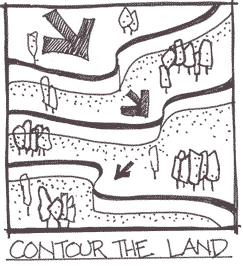
Plant in Layers.
Layered vegetation intercepts a greater amount of rainfall than a single layer such as lawn. Plant a diversity of groundcovers, shrubs and trees.
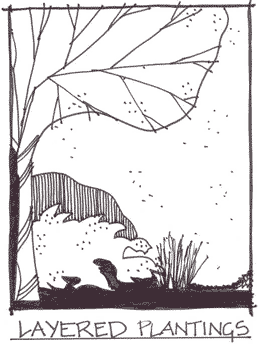
Rain Barrels.
The City of Vancouver's Water Works Department has designed a rain barrel to collect rainwater from roofs to be used as an irrigation source for gardens in periods of dry weather rather than drawing on the City's reservoirs. The cost of the rain barrels is subsidized by the City and they are available for purchase by Vancouver residents.
Permeable Paving.
Standard paving systems are usually placed on a layer of sand which is impervious to the movement of water. Permeable paving is set on coarse gravel and water is able to seep into the larger air spaces through to the soil.
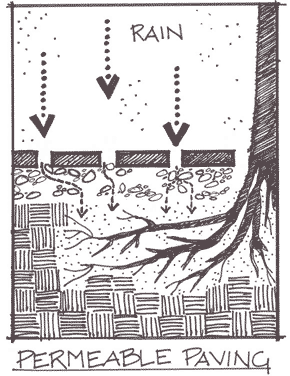
Soil Health
Composting
builds up the organic matter in the soil thereby increasing the soil's ability to retain water. By composting lawn clippings, leaves and other green waste, important nutrients, minerals, bacteria and microorganisms are recycled back into the soil.
Mulching
covers and protects the soil from drying out, prevents the loss of nutrients through leaching, and the growth of annual weeds. Mulches (leaves, straw) should always be applied when the soil is moist as they keep the soil temperature and moisture availability constant at the time of application. Green manures such as winter rye grow as a cover crop over the winter to prevent the loss of nutrients through leaching and are dug under in the spring to provide a source of nitrogen for plants.
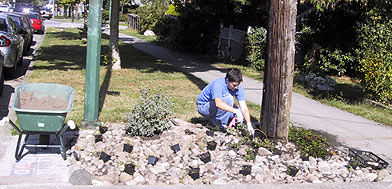
Soaker hoses and drip irrigation
direct water to plant roots and prevent the loss of water through excessive evaporation. These methods slowly release water at or just below soil grade.
Water sparingly.
Roots that have to search for water grow deeper which helps them through extended periods of drought. Plants that are adapted to dry summers do not need to be watered during dry weather once their root systems are established.
Plant Selection
Waterwise gardening is responsive to the conditions throughout the year and uses plants that thrive in periods of both inundation and drought. Select plants that prefer acidic soil conditions, resist root rot from persistent winter rains and can tolerate dry summer weather.
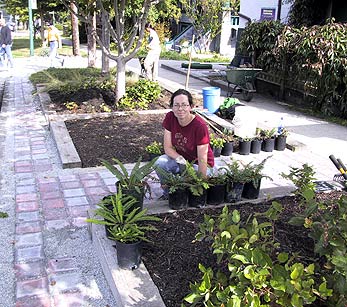
Native plants are uniquely adapted to both our wet winters and dry summers and have little dependence on supplemental water during dry weather. They also express the ecology of our region and portray the beauty of the Lower Mainland's indigenous plant communities. Ornamental species from similar climates such as the Pacific Rim, coastal areas of Europe and wet regions of the Mediterranean Basin will also thrive in our landscape.
Maintenance Techniques
Proper planning can reduce the amount of time and effort expended on tending and watering gardens. Maintain a regular schedule of care and plant thickly to create shade and smother the growth of weeds. Restrict the amount of time controlling plants that aggressively compete for light, moisture and nutrients by using plants in associations where they coexist harmoniously such as Fragaria vesca (coastal strawberry) and Arctostaphylos uva-ursi (kinnikinnik) which combine to form a lush, evergreen water thrifty alternative to lawn. The low maintenance waterwise garden requires less water, has stronger plants and benefits from improved soil.
The principles of waterwise gardening respond to the local and regional conditions of climate and weather patterns, rainfall, topography and successional plant associations. By observing the landscape and working with it more sensitively, a deeper awareness for the natural processes that shape our surroundings develops and not only do we create an improved environment for our plants but also a healthier environment to be shared by everyone.
City Farmer's Waterwise Garden
Plants Currently Displayed (2004)
TREES:| Juniperus scopulorum | Rocky mountain juniper | sun |
| Pinus parviflora 'Adcock's dwarf' | Japanese white pine | alpine garden |
| Quercus garryana | Garry oak | sun |
| Rhamnus purshiana | Cascara | sun |
| Tsuga mertensiana | Mountain hemlock | sun |
| Amelanchier alnifolia | Saskatoon berry | sun |
| Arctostaphylos columbiana | Hairy manzanita | sun |
| Arctostaphylos x. media | Hybrid manzanita | sun |
| Gaultheria shallon | Salal | part sun/shade |
| Juniperus squamata 'Blue star' | Juniper | sun |
| Mahonia aquifolium | Oregon grape | part sun/shade |
| Mahonia nervosa | Dull oregon grape | shade |
| Ribes cereum | Sqaw currant | sun |
| Ribes sanguineum | Red flowering currant | sun |
| Ribes sanguineum 'White Icicle' | White flowering currant | sun |
| Rosa woodsii | Wood's rose | sun |
| Shepherdia canadensis | Soopolallie | part sun/shade |
| Spirea betulifolia | Birch leaved spirea | sun |
| Spirea douglasii | Hardhack | part sun/shade |
| Symphoricarpus albus | Common snowberry | part sun/shade |
| Symphoricarpus mollis | Trailing snowberry | sun |
| Vaccinium ovatum | Evergreen huckleberry | sun |
| Achillea millefolium | Yarrow | sun |
| Anaphalis margaritacea | Pearly everlasting | sun |
| Anemone multifida | Cut leaf anemone | sun |
| Aquilegia Formosa | Red columbine | shade |
| Armeria maritime | Sea thrift | sun |
| Artemesia schmidtiana 'Silver mound' | Wormwood | sun |
| Aster species | Aster | sun |
| Carpobrotus chilensis | Ice plant | sun |
| Dianthus deltoides | Pink | |
| Dianthus plumaris | Pink | sun |
| Dodecatheon hendersonii | Broad leafed shooting star | shade |
| Erigonum umbellatum | Sulfur buckwheat | sun |
| Eriophyllum lanatum | Wooly sunflower | sun |
| Escholzia californica | California poppy | sun |
| Hebe 'Autumn glory' | Hebe | sun |
| Helianthemum 'Wisley primrose' | Rock rose | sun |
| Helianthemum 'Wisley white' | Rock rose | sun |
| Iberis sempervirens | Candytuft | sun |
| Lathyrus japonicus | Beach pea | sun |
| Lewisia cotyledon | Bitterroot | sun |
| Lomatium dissectum | Desert parsley | sun |
| Maianthemum stellata | Star flowered Solomon's seal | shade |
| Penstemon species | Penstemon | sun |
| Sedum spathulifolium | Stonecrop | sun |
| Sedum telephium 'Atropurpureum' | Stonecrop | sun |
| Sempervivum sp. | Hens and chicks | sun |
| Sisyrinchium douglasii | Satin flower | shade |
| Sisyrinchium littorale | Blue eyed grass | sun |
| Sisyrinchium idahoense | Shore blue eyed grass | sun |
| Blechnum spicant | Deer fern | shade |
| Polystichum munitum | Sword fern | shade |
| Arctostaphylos uva-ursi | Kinnikinnik | sun |
| Dryas octopetala | White mountain avens | sun |
| Fragaria chiloensis | Coastal strawberry | sun |
| Thymus vulgaris | Common thyme | sun |
| Festuca idahoensis var. roemeri | Idaho fescue (Roemer's) | sun |
| Allium cernuum | Nodding onion | sun |
| Brodiaea hyacinthine | Harvest brodiaea | sun |
| Camassia cusickii | Cusick's camas (blue) | sun |
| Camassia leichtlinii | Great camas (white) | sun |
| Camassia quamash | Common camas (blue) | sun |
| Dicentra Formosa | Pacific bleeding heart | shade |
| Erythronium oregonum | Fawn lily | part sun/shade |
| Iris tenax | Iris | shade |
| Narcissus 'Tete a tete' | Daffodil | sun |
| Tritelia laxa | Blue dicks | part sun/shade |
| Tulipa tarda | Species tulips | sun |
| Lonicera ciliosa | Orange honeysuckle | sun |
| Lonicera hispidula | Purple honeysuckle (trailing) | part sun/shade |
Useful Resources:
Choosing Best Plants For a Dry Summer
"Gardening - A drought tolerant label may not be enough to guarantee survival. Judith Cowan getting ready to plant a Garry oak in the waterwise garden at City Farmer. It is a boulevard garden half a city block long, and Cowan favours mostly native plants such as Rosa woodsii."
Drought Tolerant
Plant List for Vancouver City Boulevards
List compiled by volunteer Master Gardeners from Van Dusen Botanical Garden for the Prince Edward Street Waterwise Blooming Boulevard Project.
Native Plant Society of British Columbia
"The NPSBC Native Plant Society of British Columbia is an organization bringing together people from throughout the province who enjoy, study and work with native plants and habitats."
Drip Irrigation
"There are How-To articles, FAQs and online wizards for calculating which parts are needed for different types of gardens. There is also a simplified version of the 'How much water does a plant need on a summer day?' formula."

